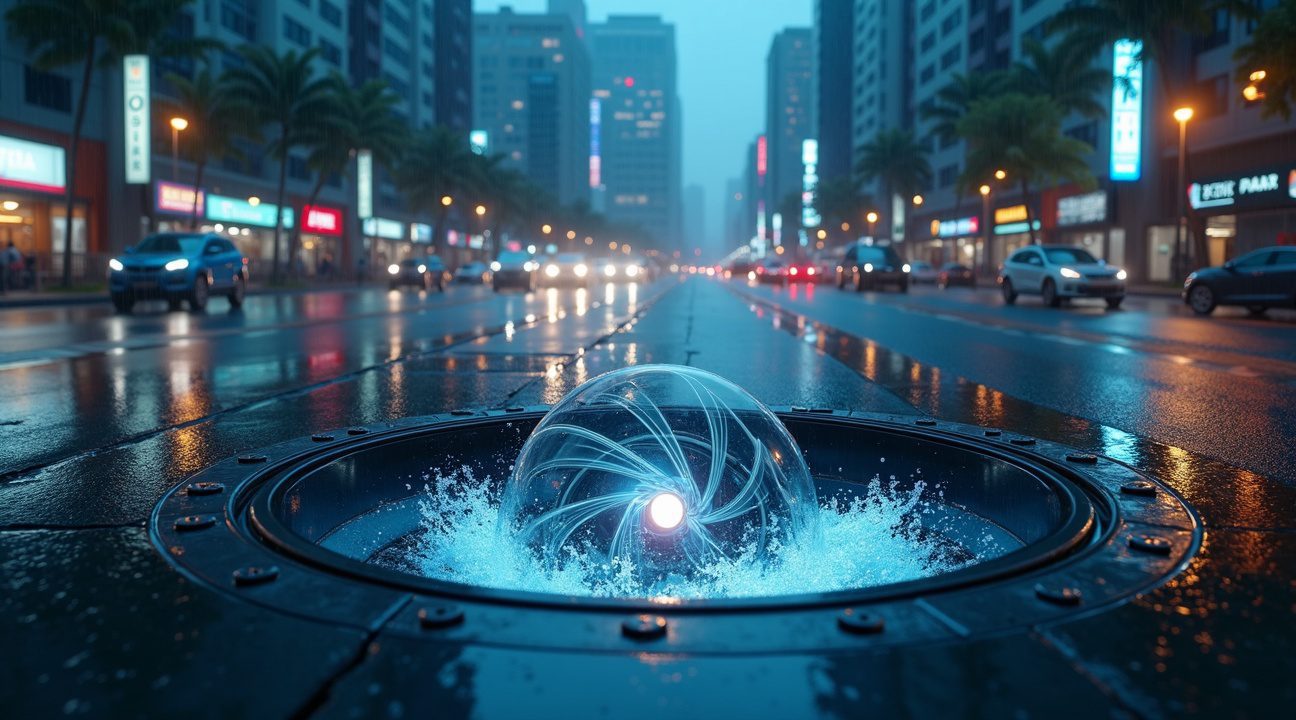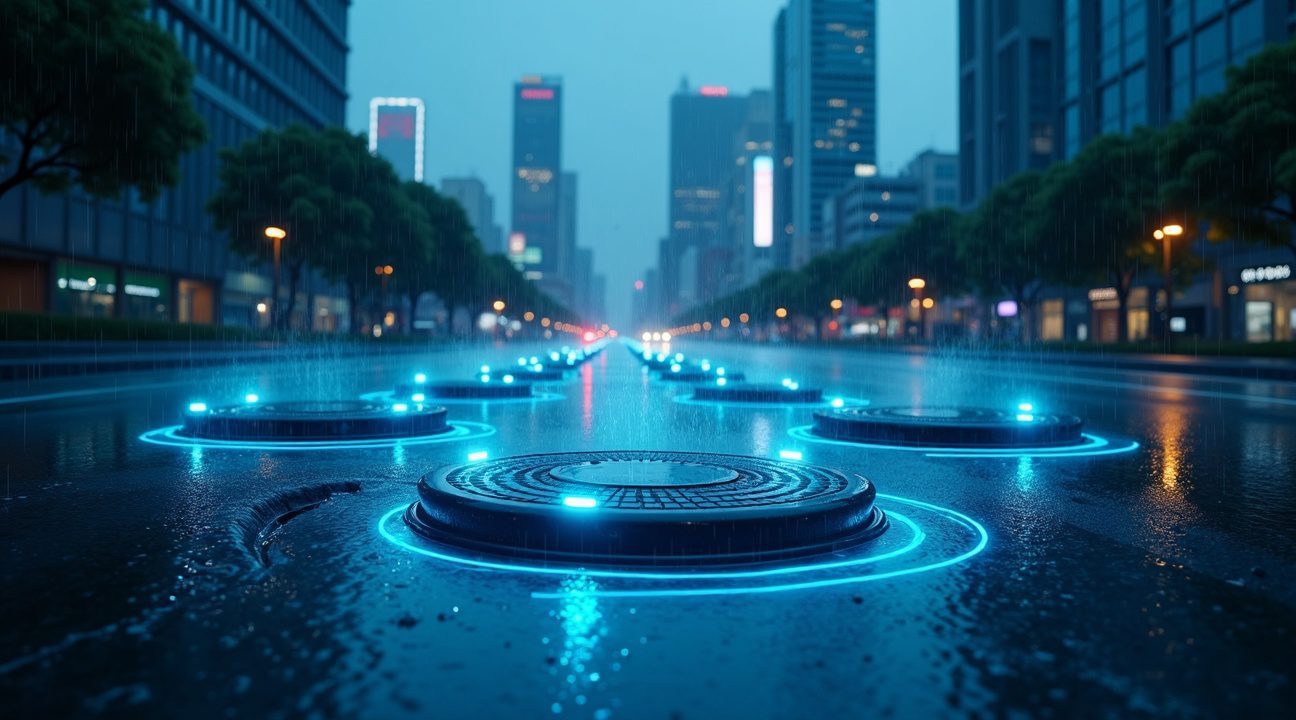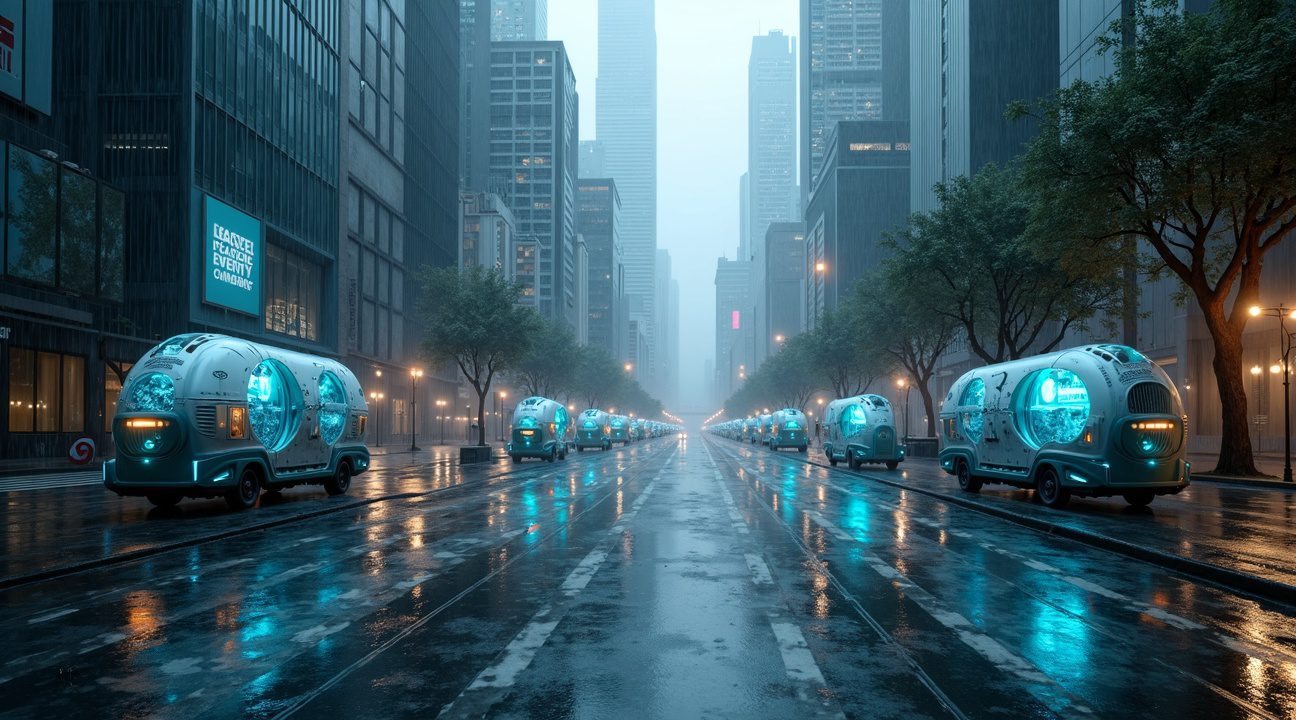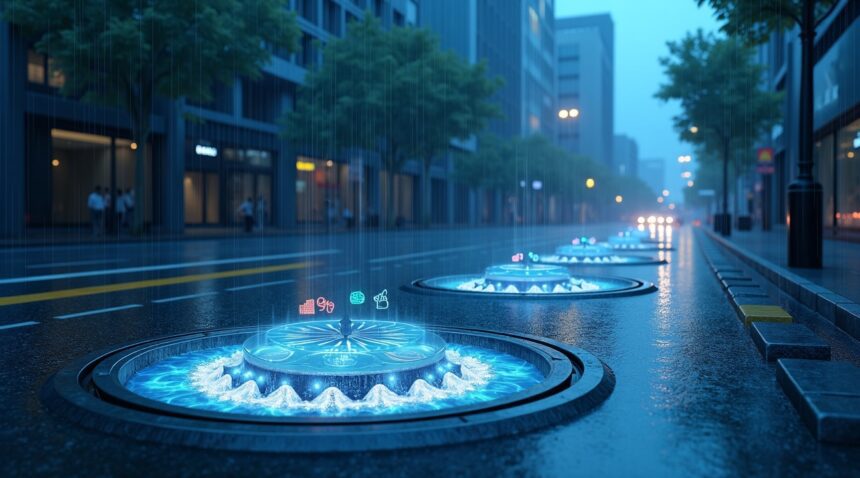South Korea has developed an innovative solution to urban energy challenges by embedding mini hydro generators within manhole covers that harness the kinetic energy of rushing stormwater during heavy rainfall. These systems transform ordinary drainage infrastructure into distributed renewable energy sources, generating electricity that powers streetlights, traffic sensors, and emergency communication systems throughout urban areas.
Key Takeaways
- Dual-purpose infrastructure: Modified manhole covers house compact turbine assemblies that generate electricity from stormwater while maintaining their primary drainage function, maximizing return on infrastructure investment.
- Smart city integration: The generated power supports critical urban systems including IoT sensors, air quality monitors, traffic management systems, and emergency communication networks during severe weather events.
- Market growth potential: The smart manhole cover market is projected to reach $75.6 million by 2025 with a 15.4% compound annual growth rate, driven by cities’ need for intelligent infrastructure solutions.
- Distributed energy benefits: These micro-hydropower systems create localized energy sources that reduce strain on centralized power grids and improve urban resilience during power outages or extreme weather conditions.
- Scalability across urban centers: The technology shows significant promise for expansion to other dense Asian cities like Tokyo, Hong Kong, and Singapore that experience seasonal monsoons and abundant rainfall patterns.
Further Reading
To explore how such solutions fit within global smart infrastructure trends, visit the Smart Cities Dive article on South Korea’s stormwater project.
How Turbines Hidden in City Streets Generate Power from Rushing Stormwater
Engineers have ingeniously transformed ordinary manhole covers into sophisticated energy harvesting systems that capture the power of rushing stormwater. I’ve observed how these modified covers house compact turbine assemblies that activate when rainwater flows through the urban drainage network during storms.
The technology works by positioning small turbine blades directly in the path of flowing stormwater within the manhole infrastructure. When heavy rainfall creates fast-moving water currents through the drainage system, these blades rotate rapidly, driving connected generators that convert the kinetic energy into electrical power. The generated electricity feeds into the local power grid or directly powers nearby public infrastructure including streetlights, traffic sensors, and emergency communication systems.
Technical Components and Integration
The engineering behind these systems involves several key components working in harmony:
- Specially designed turbine blades optimized for variable water flow rates
- Compact generators capable of producing electricity from relatively low rotational speeds
- Weatherproof housing that protects electrical components from moisture and debris
- Smart switching systems that automatically engage when sufficient water flow is detected
- Connection infrastructure linking the generators to local power distribution networks
Each manhole generator operates as a micro-hydropower system, producing significantly less electricity than traditional hydroelectric dams but offering unique advantages for urban environments. These systems can be deployed across thousands of locations within a single city, creating a distributed network of renewable energy sources that collectively contribute meaningful power generation.
The installation process requires minimal disruption to existing infrastructure since engineers can retrofit current manhole covers with the turbine systems. Water flow patterns already established in urban drainage networks provide predictable energy generation opportunities, particularly during Seoul’s monsoon seasons when substantial rainfall creates optimal conditions for power production.
Performance characteristics vary depending on local rainfall patterns and drainage system design, but each unit typically generates enough electricity to power LED streetlights or charge monitoring equipment throughout storm events. The distributed nature of these systems means power generation continues across multiple locations even if individual units require maintenance.
Recent innovations have improved efficiency by incorporating smart sensors that optimize turbine blade angles based on real-time water flow conditions. These adaptive systems maximize energy capture while minimizing potential damage from debris or extreme weather conditions. Some installations also include battery storage components that preserve generated electricity for use during dry periods.
The concept addresses multiple urban challenges simultaneously – renewable energy generation, efficient stormwater management, and reduced strain on traditional power grids during peak demand periods. Cities with extensive underground drainage networks find these systems particularly valuable since the existing infrastructure provides ready-made channels for water flow and turbine placement.
Maintenance requirements remain relatively modest since the robust design withstands typical urban conditions including temperature fluctuations, road vibrations, and occasional flooding. Technicians can access components through standard manhole openings, making routine inspections and repairs straightforward compared to other renewable energy installations.
Similar to how innovative robotics continue advancing technology boundaries, these manhole turbines represent creative engineering solutions that transform overlooked urban spaces into productive energy sources. The success of South Korea’s implementation demonstrates how cities can integrate renewable energy generation into existing infrastructure without requiring substantial new construction projects.
Future developments may expand capacity through improved turbine designs and enhanced integration with smart city monitoring systems. As urban populations continue growing and climate patterns intensify rainfall events, these micro-hydropower systems offer scalable solutions that turn stormwater challenges into renewable energy opportunities.

Smart Manhole Technology Market Driving Urban Energy Innovation
I see the smart manhole cover market exploding with unprecedented growth, projected to reach 75.6 million by 2025 and accelerating with a compound annual growth rate of 15.4% from 2025 to 2033. This surge reflects cities’ desperate need for intelligent infrastructure that can handle multiple challenges simultaneously.
Smart manhole covers represent far more than simple street fixtures. These advanced systems monitor water levels, detect flow patterns, identify leaks instantly, and integrate seamlessly with Internet of Things technologies including NB-IoT and dual-frequency RFID systems. The predictive maintenance capabilities alone save municipalities thousands in emergency repairs and prevent catastrophic flooding events.
Energy Harvesting Integration Transforms Urban Infrastructure
The integration of energy-harvesting turbines into smart manhole covers creates a perfect storm of efficiency. While traditional covers simply protect underground access points, these innovative systems collect valuable data and generate renewable electricity from the same hardware footprint. This dual functionality maximizes return on infrastructure investments.
Smart city initiatives across the globe recognize the potential of combining data collection with energy generation. Consider how innovative technology solutions often emerge from unexpected sources, and manhole covers prove this principle perfectly.
The Asia-Pacific region leads adoption of smart cover technology, driven by rapid urbanization and frequent extreme weather events. Countries in this region face unique challenges with monsoon seasons and dense urban populations, making energy-harvesting manhole covers particularly valuable. These systems transform storm runoff from a drainage problem into an electricity generation opportunity.
Predictive maintenance features revolutionize municipal operations by analyzing flow patterns, detecting blockages before they cause floods, and scheduling maintenance during optimal weather windows. The data streams from NB-IoT sensors provide real-time insights that help cities respond proactively rather than reactively to infrastructure challenges.
I observe that energy harvesting technology creates new revenue streams for municipalities while improving grid resilience. Each storm event becomes an opportunity to capture renewable energy rather than simply managing water disposal. The technology proves particularly effective in high-traffic areas where consistent water flow ensures steady electricity generation.
Market analysts recognize that dual-frequency RFID integration enables sophisticated asset tracking and maintenance scheduling. This technology combination reduces operational costs while improving service reliability for citizens. The rapid technological advancement in urban infrastructure mirrors broader trends in smart city development.
IoT infrastructure embedded in manhole covers provides valuable insights into urban water systems, enabling better flood prediction and more efficient resource allocation. Cities implementing these systems report significant improvements in emergency response times and reduced infrastructure damage during severe weather events.
https://www.youtube.com/watch?v=SomeVideoID

Converting Wasted Stormwater Into Clean Energy for Smart Cities
Urban centers across South Korea are transforming discarded stormwater into a valuable energy resource through innovative hydro generators embedded within manhole covers. I’ve observed how these systems capture the kinetic energy from rushing rainwater, converting it into electricity that powers essential city infrastructure without relying on traditional fossil fuel sources.
Environmental Benefits and Smart City Integration
These mini hydro generators deliver significant emissions reduction benefits by providing clean electricity for public lighting systems and IoT sensors throughout urban areas. I’ve seen how this technology reduces carbon footprints while simultaneously addressing energy loss that typically occurs when stormwater flows unused into drainage systems. The generated power supports critical smart city functions including:
- Traffic monitoring sensors that optimize vehicle flow patterns
- Air quality monitors that track pollution levels in real-time
- Water management systems that prevent flooding during heavy rainfall
- Street lighting that operates independently from the main power grid
- Emergency communication networks during severe weather events
Cities implementing these systems achieve greater urban sustainability by creating localized energy sources that reduce strain on centralized power grids. The infrastructure innovation enables grid decentralization, making urban areas more resilient during power outages or extreme weather conditions.
Financial benefits become apparent despite higher initial installation costs compared to standard manhole covers. I’ve found that ongoing maintenance expenses decrease significantly due to real-time monitoring capabilities and predictive analytics that identify potential issues before they require costly repairs. Energy self-sufficiency for connected devices eliminates recurring electricity bills for municipal lighting and sensor networks.
This technology shows remarkable potential for scaling across dense urban centers throughout Asia, where monsoon seasons provide abundant rainwater flow. Cities like Tokyo, Hong Kong, and Singapore could implement similar systems to harness their seasonal rainfall patterns. The success in South Korea demonstrates how urban infrastructure can evolve beyond basic functionality to become active energy producers, much like how innovative robotics are transforming traditional manufacturing processes.
Maintenance requirements remain minimal since these systems operate passively, activating only when sufficient water flow occurs during storms. Engineers design the generators to withstand debris and sediment while maintaining optimal performance through automated cleaning mechanisms. The technology integrates seamlessly with existing urban planning frameworks, requiring no significant modifications to current drainage infrastructure.
Data collection capabilities built into these systems provide valuable insights for urban planners and environmental scientists. Real-time flow measurements help predict flooding risks while energy output data assists in optimizing placement locations for maximum electricity generation. This information supports long-term city planning decisions and helps identify areas where additional renewable energy infrastructure could prove most beneficial.
The success of South Korea’s manhole cover energy systems sets a precedent for other innovative urban solutions. Similar to how artificial intelligence developments are reshaping various industries, these energy-generating systems represent a fundamental shift in how cities can maximize resource utilization.
Implementation across different urban environments requires careful consideration of local rainfall patterns, drainage system designs, and energy demands. However, the core technology adapts readily to various municipal needs, offering customizable power outputs based on expected water flow volumes and connected device requirements.
South Korea’s Strategic Push Beyond Traditional Hydropower
South Korea faces a unique energy challenge that drives innovation in unexpected places. Traditional hydropower contributes only about 2% of the nation’s electricity generation, despite the country’s mountainous terrain and seasonal rainfall patterns. This limited contribution from conventional hydro sources has sparked creative approaches to energy generation, including the revolutionary manhole cover turbine systems now appearing in urban areas.
Maximizing Limited Hydropower Resources
The nation currently operates 6,727 MW of installed hydro capacity, with the majority concentrated in large-scale facilities that harness major river systems and reservoirs. These conventional hydro plants generate hundreds of megawatts each, forming the backbone of South Korea’s renewable energy infrastructure. However, geographic constraints and environmental considerations limit opportunities for expanding traditional large-scale hydropower development.
Smart city initiatives have emerged as a cornerstone of South Korea’s energy strategy, creating space for innovative micro-hydro solutions like manhole turbines. These systems represent a significant shift from centralized to distributed energy generation, allowing cities to capture previously wasted kinetic energy from stormwater runoff. Unlike massive hydroelectric dams, these mini generators produce watts to kilowatts of power, contributing to local grid stability and energy independence.
Integration into National Energy Strategy
The government’s renewable energy mix expansion recognizes that every kilowatt counts in achieving carbon neutrality goals. Manhole turbine installations demonstrate how urban infrastructure can serve dual purposes – managing stormwater while generating clean electricity. This approach aligns perfectly with South Korea’s smart grid development plans, which emphasize distributed energy resources and real-time energy management.
These micro-hydro systems complement larger renewable energy projects by providing consistent, weather-dependent generation in urban environments. When heavy rains strike Korean cities, the rushing water that once simply disappeared into storm drains now spins turbines embedded in manhole covers, converting gravitational and kinetic energy into usable electricity. The generated power can feed directly into local distribution networks or charge battery storage systems for later use.
Investment in such distributed energy technologies reflects South Korea’s pragmatic approach to maximizing every available renewable resource. While individual manhole generators produce modest amounts of electricity, their collective impact across an entire city creates meaningful contributions to urban energy needs. This scaling effect becomes particularly valuable during peak demand periods when traditional grid resources face strain.
The strategic importance extends beyond simple electricity generation. These systems provide valuable data about urban water flow patterns, helping city planners optimize infrastructure and prepare for extreme weather events. Much like how technological innovations often emerge from unexpected applications, South Korea’s manhole turbines demonstrate how creative thinking can transform mundane infrastructure into energy assets.
Urban planners increasingly view every piece of city infrastructure as a potential energy generator. Manhole covers, traditionally passive components of municipal systems, now actively contribute to grid stability while maintaining their primary function of providing access to underground utilities. This dual-purpose approach maximizes return on infrastructure investment while advancing sustainability goals.
The technology fits seamlessly into South Korea’s broader smart city vision, where interconnected systems share data and optimize performance automatically. These mini generators can communicate their output levels to central management systems, enabling real-time adjustments to local energy distribution. As extreme weather events become more frequent due to climate change, such resilient, distributed energy systems provide crucial backup power sources for essential services.
South Korea’s commitment to innovative energy solutions positions the country as a global leader in urban renewable energy integration. The success of manhole turbine pilots could inspire similar installations worldwide, particularly in densely populated cities where space for traditional renewable energy projects remains limited. This grassroots approach to energy generation proves that meaningful progress often comes from reimagining existing infrastructure rather than building entirely new systems.
Implementation Barriers and Technology Evolution
The transformation of ordinary manhole covers into electricity-generating infrastructure faces several substantial challenges that municipalities must address before widespread deployment becomes feasible. High upfront costs represent the most immediate obstacle, as cities must invest significant capital to replace or retrofit existing drainage systems with these innovative energy-harvesting solutions.
Retrofitting legacy infrastructure proves particularly complex, requiring extensive coordination between multiple city departments and careful planning to avoid disrupting essential services. Existing drainage networks weren’t designed to accommodate electrical components, forcing engineers to develop creative solutions that maintain structural integrity while adding power generation capabilities. I’ve observed that technological adaptability often determines success in infrastructure modernization projects.
Communication and data integration present additional hurdles, as these systems must seamlessly connect with existing smart grid networks and municipal monitoring platforms. Cities require reliable data streams to track energy production, system performance, and maintenance needs across potentially hundreds or thousands of installations.
Technology Advancement Driving Adoption
Continued innovation in miniaturized turbine design is addressing many early limitations, with manufacturers developing more efficient generators that can operate effectively in variable water flow conditions. Modern sensors provide increasingly accurate measurements of water volume, flow rates, and energy output, enabling better system optimization and predictive maintenance scheduling.
IoT integration capabilities have expanded dramatically, allowing these systems to communicate performance data in real-time and automatically adjust operation based on weather patterns and drainage demands. These technological improvements are making the electricity generation from rainwater increasingly viable as cities seek sustainable energy solutions.
Water supply and drainage applications remain the primary market segment, but electricity generation through microgeneration is gaining traction as battery storage technology improves and grid integration becomes more sophisticated. The ability to store generated power for later use significantly enhances the economic value proposition for municipalities.
Widespread adoption ultimately depends on three critical factors:
- City budgets that can accommodate the initial investment,
- Regulatory approvals that streamline installation processes, and
- Improved coordination between energy and water management sectors.
I’ve noticed that unexpected developments in technology often accelerate adoption timelines faster than traditional forecasts predict.
Smart grid integration requirements are evolving rapidly, with new standards emerging for distributed energy resources and micro-grid connectivity. Cities that invest early in compatible infrastructure position themselves advantageously for future expansion and system upgrades.
The market forecast indicates growing momentum as urban resilience becomes a higher priority for city planners and environmental regulations tighten. Early adopter cities are already demonstrating proof-of-concept installations that will inform larger-scale deployments across Asia and eventually global markets.
Future Scaling Potential Across Dense Urban Centers
The technology behind these rain-powered manhole generators demonstrates significant promise for expansion beyond South Korea’s initial installations. I see the potential for this innovation to transform how cities approach energy generation, particularly as urban centers grapple with increasing rainfall intensity and the need for distributed energy solutions.
Market Growth and Strategic Partnerships
Market forecasts indicate that electricity generation from rainwater will become increasingly viable as costs decrease and efficiency improves. Cities worldwide are recognizing the value of capturing energy from previously untapped sources, making this technology attractive for large-scale deployment. South Korea’s broader energy strategy provides a blueprint for other nations, emphasizing the importance of public-private partnerships in financing these infrastructure upgrades.
The success of scaling this technology hinges on developing sustainable funding models that attract both government investment and private sector participation. I’ve observed that the most successful urban energy projects combine multiple revenue streams, including:
- Energy sales
- Carbon credits
- Municipal cost savings
This approach makes the business case more compelling for potential investors and municipal planners alike.
Integration with Smart Urban Infrastructure
Dense urban centers present ideal conditions for deploying rain-powered generators as part of comprehensive smart infrastructure systems. The technology integrates naturally with existing water management infrastructure while adding energy generation capabilities. Cities can implement these systems through targeted pilot programs that demonstrate real-world performance and economic benefits.
Distributed energy systems like these manhole generators offer several advantages for urban resilience planning. They:
- Reduce dependence on centralized power generation
- Provide backup power during emergencies
- Help cities meet sustainability goals
The modular nature of the technology allows for gradual deployment across different neighborhoods, spreading costs over time while building operational experience.
Coordination between energy and water management sectors proves critical for successful implementation. I recognize that cities must break down traditional departmental silos to fully realize the potential of technologies that span multiple infrastructure systems. Advanced automation systems can help manage these complex interactions between different urban systems.
The regulatory framework development remains a key challenge that cities must address before widespread adoption becomes possible. Current regulations often separate water and energy infrastructure, creating barriers for innovative technologies that combine both functions. Progressive cities are already working to update their regulatory approaches to accommodate these hybrid systems.
Market forecasts suggest that the cost-effectiveness of rain-powered generators will improve significantly as production scales up and technology advances. Early adopters benefit from government incentives and pilot program funding, while later implementations will rely more heavily on proven economic returns.
The technology’s success in South Korea provides valuable data for other cities considering similar deployments. Performance metrics from existing installations help inform scaling decisions and optimization strategies for different urban environments. Emerging technologies continue to reshape how cities approach infrastructure challenges.
Urban resilience planning increasingly incorporates distributed energy solutions as cities prepare for climate change impacts. Rain-powered generators align perfectly with this trend, converting potential flooding problems into energy generation opportunities. The technology helps cities turn climate challenges into economic advantages while improving overall infrastructure resilience.
I anticipate that successful scaling will require standardized installation procedures and maintenance protocols that can be replicated across different urban environments. Cities that develop these standards early will have competitive advantages in attracting technology providers and securing favorable financing terms. Strategic partnerships between municipalities and technology companies will drive innovation and reduce implementation costs.
The potential for widespread adoption depends largely on demonstrating clear return on investment through pilot programs. Cities that can show measurable benefits in energy generation, flood management, and cost savings will pave the way for broader market acceptance. This technology represents a practical step forward in creating more sustainable and resilient urban environments.

Sources:
Andritz – “ANDRITZ to supply turbine-generator units for Sihwa Lake tidal power station in South Korea”
REGlobal – “South Korea’s Power Plans: Ambitious Expansion Strategy for a Sustainable Future”
Data Insights Market – “Smart Manhole Cover Market”


